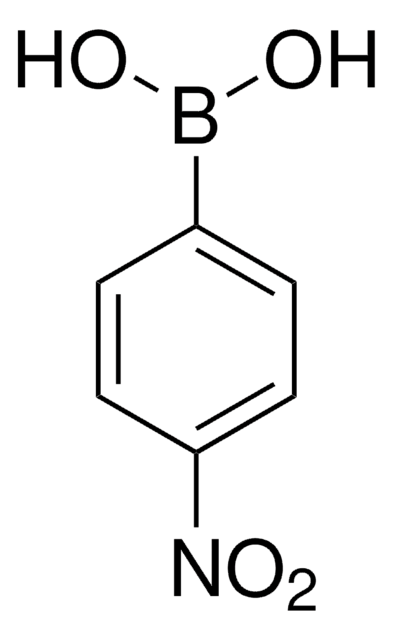417599
4-Methoxyphenylboronic acid
≥95.0%
Sinónimos:
(4-Methoxyphenyl)boric acid, (p-Methoxyphenyl)boronic acid, 4-Anisylboronic acid, 4-Methoxybenzeneboronic acid, p-Anisylboronic acid, p-Methoxybenzeneboronic acid
About This Item
Productos recomendados
assay
≥95.0%
form
powder
mp
204-206 °C (lit.)
SMILES string
COc1ccc(cc1)B(O)O
InChI
1S/C7H9BO3/c1-11-7-4-2-6(3-5-7)8(9)10/h2-5,9-10H,1H3
InChI key
VOAAEKKFGLPLLU-UHFFFAOYSA-N
¿Está buscando productos similares? Visita Guía de comparación de productos
Categorías relacionadas
Application
- Suzuki-Miyaura cross-coupling reactions
- Pd-catalyzed direct arylation
- Highly effective synthesis using palladium-catalyzed arylation Suzuki-Miyaura cross-coupling in water
- Palladium-catalyzed stereoselective Heck-type reaction
- Tandem-type Pd(II)-catalyzed oxidative Heck reaction and intramolecular C-H amidation sequence
- Copper-mediated ligandless aerobic fluoroalkylation of arylboronic acids with fluoroalkyl iodides
- Ruthenium catalyzed direct arylation
- Rh-catalyzed asymmetric conjugate addition
- Ligand-free copper-catalyzed coupling
Reagent used in Preparation of
- Palladium(II) thiocarboxamide complexes as Suzuki coupling catalyst
- Push-pull arylvinyldiazine chromophores with photophysical properties
Other Notes
signalword
Warning
hcodes
Hazard Classifications
Eye Irrit. 2 - Skin Irrit. 2 - STOT SE 3
target_organs
Respiratory system
Storage Class
11 - Combustible Solids
wgk_germany
WGK 3
flash_point_f
Not applicable
flash_point_c
Not applicable
ppe
dust mask type N95 (US), Eyeshields, Gloves
Certificados de análisis (COA)
Busque Certificados de análisis (COA) introduciendo el número de lote del producto. Los números de lote se encuentran en la etiqueta del producto después de las palabras «Lot» o «Batch»
¿Ya tiene este producto?
Encuentre la documentación para los productos que ha comprado recientemente en la Biblioteca de documentos.
Los clientes también vieron
Nuestro equipo de científicos tiene experiencia en todas las áreas de investigación: Ciencias de la vida, Ciencia de los materiales, Síntesis química, Cromatografía, Analítica y muchas otras.
Póngase en contacto con el Servicio técnico


![[Pd(OAc)2]3 reagent grade, 98%](/deepweb/assets/sigmaaldrich/product/structures/508/249/99a0ef2c-b77c-4d73-8ed9-0cca05b6b41f/640/99a0ef2c-b77c-4d73-8ed9-0cca05b6b41f.png)










